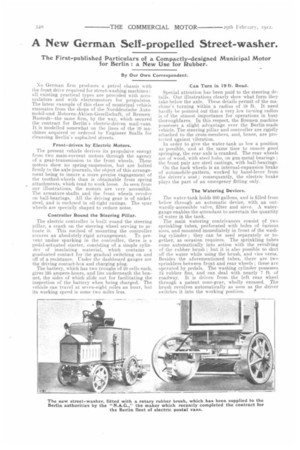A New German Self-propelled Street-washer.
Page 4

If you've noticed an error in this article please click here to report it so we can fix it.
The First-published Particulars of a Compactly-designed Municipal Motor for Berlin : a New Use for Rubber.
By Our Own Correspondent.
No German firm. produces a petrol chassis with the front drive required for street-washing machines : all existing practical types are provided with accumulators and with electromotors for propulsion. The latest example of this class of municipal vehicle emanates from the shops of the Norddeutsche Automobil-und 31otoren-Aktien-Gesellschaft, of Bremen 1-Ia.stedt—the same firm, by the way, which secured the contract for Berlin's electric-driven mail-vans. It is modelled somewhat on the lines of the 30 machines acquired or ordered by Engineer Szalla for cleansing Berlin's asphalted streets.
Front-driven by. Electric Motors.
The present vehicle derives its propulsive energy from two main-current motors through the agency of a gear-transmission to the front wheels. These motors show no spring-suspension, but. are bolted firmly to the axle-journals, the object of this arrangement being to insure a more precise engagement of the toothed-wheels than is obtainable from spring attachments, which tend to work loose. As seen from our illustrations, the motors are very accessible. The armature-shafts and the front wheels revolve on ball-bearings. All the driving gear is of nickelsteel, and is enclosed in oil-tight casings. The spur wheels are specially shaped to reduce noise.
Controller Round the Steering Pillar.
The electric controller is built round the steering pillar, a crank on the steering wheel serving to actuate it. This method of mounting the controller secures an absolutely-rigid arrangement. To prevent undue sparking in the controller, there is a pedal-actuated starter, consisting of a simple cylinder of insulating material, which contains a graduated contact for the gradual switching on and off of a resistance. Under the dashboard gauges are the driving contact-box and charging plug. The battery, which has two troughs of 20 cells each, gives 195 ampere-hours, and lies underneath the bonnet, the sides of which slide out for facilitating the inspection of the battery when being charged. The vehicle can travel at seven-eight. miles an hour, but its working speed is some two miles less. Can Turn in 19 ft.. Read.
Special attention has been paid to the steering details. Our illustrations clearly show what form they take below the axle. These details permit of the machine's turning within a radius of 19 ft.. It need hardly be pointed out that. a very low turning radius is of the utmost importance for operations in busy thoroughfares. In this respect, the Bremen machine possesses a slight advantage over the Berlin-made vehicle. The steering pillar and controller are rigidly attached to the cross-members, and, hence, are protected against vibration. In order to give the water-tank as low a position as possible, and at the same time to ensure good springing, the rear axle is cranked. The rear wheels are of wood, with steel hubs, on gun-metal bearings ; the front pair are steel castings, with ball-bearings. On the back wheels is an internal-expansion brake of automobile-pattern, worked by hand-lever from the driver's seat ; consequently, the electric brake plays the part of an emergency fitting only.
The watering Device s.
The water-tank holds 600 gallons, and is filled from below through an automatic device, with an outwardly-accessible valve, filter and sieve. A watergauge enables the attendant to ascertain the quantity of water in the tank.
The main watering contrivances consist of two sprinkling tubes, perforated with holes of various sizes, and mounted immediately in front of the washing cylinder ; they can be used separately or together, as occasion requires. The sprinkling tubes come automatically into action with the revolving of the rubber brush ; but it is also possible to shut off the water while using the brush, and vice versa. Besides the aforementioned tubes, there are two sprinklers between front and rear wheels ; these are operated by pedals. The washing cylinder possesses 24. rubber fins, and can deal with nearly 7 ft. of roadway. It is driven from the left rear wheel through a patent cone-gear, wholly encased. The brush revolves automatically as soon as the driver switches it into the working position.






















